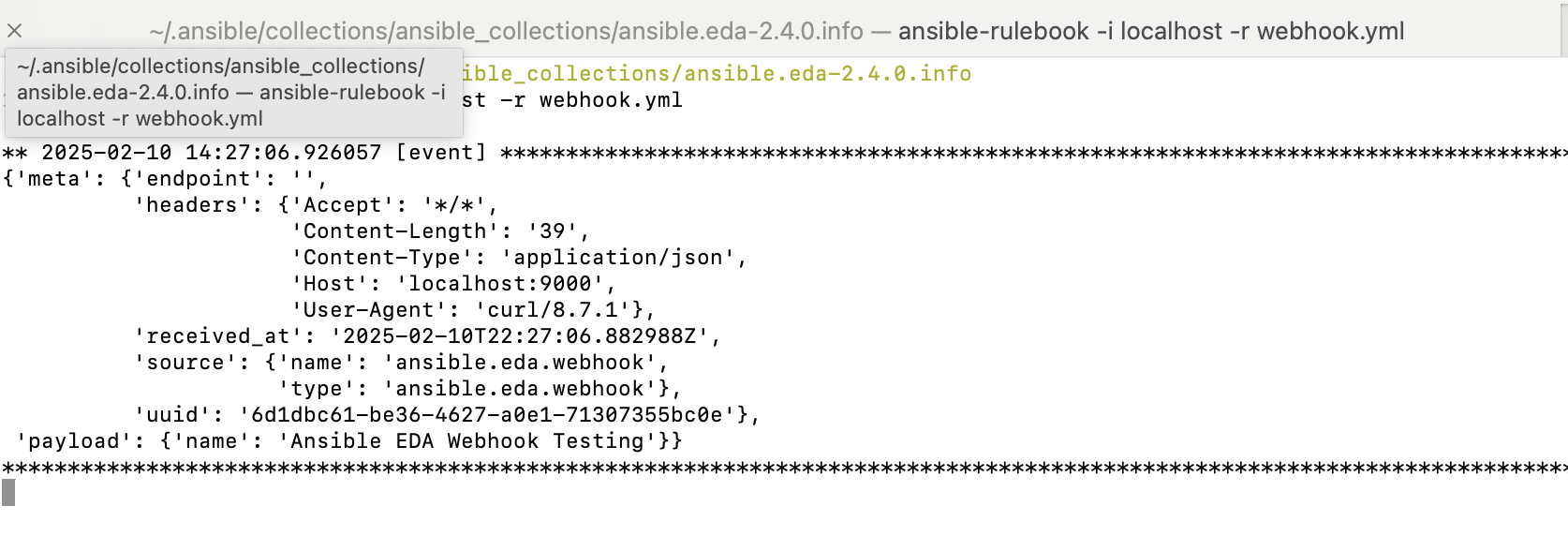Key Use Cases of the Event-Driven Ansible Webhook Module
The ansible.eda.webhook plugin automates workflows via webhooks, aiding CI/CD, incident response, config management, compliance, and cloud infrastructure.
Join the DZone community and get the full member experience.
Join For FreeThe ansible.eda.webhook plugin is a powerful Event-Driven Ansible (EDA) tool that listens for incoming HTTP webhook requests and triggers automated workflows based on predefined conditions. It’s highly versatile and can be applied across various industries and IT operations.
Key Use Cases
Automated Incident Response
A major use case for ansible.eda.webhook is in automated incident response. When monitoring tools like Prometheus, Nagios, or Datadog spot issues or failures, they can send webhook alerts to Ansible, which then automatically runs playbooks to troubleshoot and fix the problem. This could involve restarting services, scaling up infrastructure, or rolling back recent deployments.
Handling these tasks automatically helps resolve issues faster, reduces downtime, and improves overall system reliability.
Continuous Integration and Continuous Deployment (CI/CD) Pipelines
Webhooks play a crucial role in CI/CD workflows. Platforms like GitHub, GitLab, or Jenkins send webhooks whenever code is committed, a pull request is made, or a build succeeds.
With ansible.eda.webhook, these events can automatically trigger Ansible playbooks to deploy applications, run tests, or configure environments. This automation speeds up software delivery, makes deployments more reliable, and minimizes the need for manual intervention in the process.
Real-Time Configuration Management
Webhooks make it easy for organizations to manage configuration changes in real time. For instance, when a new configuration file is uploaded to a central repository or a change is made in a cloud management system, a webhook can automatically trigger Ansible to update the configuration across all servers. This keeps systems aligned with the latest settings, ensuring consistency and preventing issues caused by outdated configurations.
Security Event Monitoring and Response
SIEM tools like Splunk or ELK Stack can send webhook alerts whenever they detect potential security threats, such as unauthorized access attempts or suspicious activity. With ansible.eda.webhook, these alerts can automatically trigger security playbooks that isolate compromised systems, revoke access for unauthorized users, or alert the security team. This automation helps organizations respond to security incidents faster and stay compliant with security regulations.
Cloud Infrastructure Management
Cloud platforms can send webhook notifications for things like resource changes, system failures, or billing alerts. With ansible.eda.webhook, these events can trigger automated actions to manage cloud resources — like scaling instances, adjusting load balancers, or keeping track of costs. This kind of dynamic response helps ensure that cloud resources are used efficiently and costs are kept under control.
Automated Compliance Audits
Regulatory compliance often requires organizations to perform regular audits and generate detailed reports. With webhooks from compliance monitoring tools, Ansible can automatically kick off these audits, create compliance reports, and even fix configurations that don’t meet required standards. This helps organizations stay continuously compliant with regulations like GDPR, HIPAA, and PCI-DSS — all without needing manual effort.
Demo
Here’s a sample code snippet of a webhook that listens on port 9000. Whenever it receives an event, it prints the event details to the screen using print_event action.
- name: webhook demo
hosts: localhost
sources:
- ansible.eda.webhook:
port: 9000
host: 0.0.0.0
rules:
- name: Webhook rule
condition: true
action:
print_event:
pretty: trueThe following curl command sends a POST request to the Event-Driven Ansible webhook running on http://localhost:9000/.
curl --header "Content-Type: application/json" \
--request POST \
--data '{"name": "Ansible EDA Webhook Testing"}' \
http://localhost:9000/Here’s the screenshot from running the ansible-rulebook -i localhost -r webhook.yml command, which displays the response from the above curl command.

Conclusion
The ansible.eda.webhook plugin is a powerful tool that brings real-time automation and responsiveness to IT operations. By listening for webhook events from various sources — such as monitoring tools, CI/CD platforms, and cloud services — it enables organizations to automate incident response, streamline deployments, and maintain system compliance with minimal manual intervention.
Its flexibility and ease of integration make it an essential component for modern, event-driven infrastructures, helping teams improve efficiency, reduce downtime, and ensure consistent, reliable operations.
Note: The views expressed on this blog are my own and do not necessarily reflect the views of Oracle.
Opinions expressed by DZone contributors are their own.

Comments